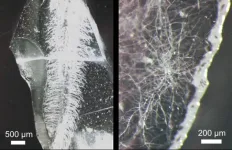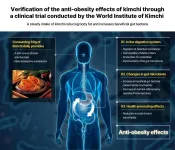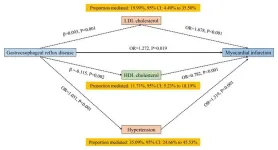(Press-News.org)
Fukuoka, Japan— Microfluidic technology has become increasingly important in many scientific fields such as regenerative medicine, microelectronics, and environmental science. However, conventional microfabrication techniques face limitations in scale and in the construction of complex networks. These hurdles are compounded when it comes to building more intricate 3D microfluidic networks.
Now, researchers from Kyushu University have developed a new and convenient technique for building such complex 3D microfluidic networks. Their tool? Plants and fungi. The team developed a ‘soil’ medium using nanoparticles of glass (silica) and a cellulose based binding agent, then allowed plants and fungi to grow roots into it. After the plants were removed, the glass was left with a complex 3D microfluidic network of micrometer-sized hollow holes where the roots once were.
The new method can also be utilized for observing and preserving 3D biological structures that are typically difficult to study in soil, opening new opportunities for research in plant and fungal biology. Their findings were published in the journal Scientific Reports.
“The primary motivation for this research was to overcome the limitations of conventional microfabrication techniques in creating complex 3D microfluidic structures. The focus of our lab is biomimetics, where we try to solve engineering problems by looking to nature and artificially replicating such structures,” explains Professor Fujio Tsumori of Kyushu University’s Faculty of Engineering, who led the study. “And what better example of microfluidics in nature than plant roots and fungal hyphae? So, we set out to develop a method that could harness the natural growth patterns of these organisms and create optimized microfluidic networks.”
The researchers began by developing a ‘soil’ like mix for plants to grow in, but instead of dirt, they combined growth medium with glass nanoparticles smaller than 1 μm in diameter with hydroxypropyl methyl cellulose as a binding agent. They then seeded this ‘soil’ mixture and waited for the plants to take root. After confirming successful plant growth, the ‘soil’ was baked leaving only the glass with root cavities.
“The process is called sintering, which aggregates fine particles together into a more solid state. It is similar to powder metallurgy in the manufacturing of ceramics,” continues Tsumori. “In this case it is the plant that does the molding.”
Their method was able to replicate the intricate biological structures of a plant’s main roots which can be up to 150 μm in diameter, and all the way down to it root hairs which can be about 8 μm in diameter. Tests with other organisms showed that the method can even replicate the root structure of fungi, called hyphae.
“Hyphae are even thinner and can be as small as 1-2 μm in diameter. That’s thinner than a single strand of spider silk,” says Tsumori.
The team hopes that their new bio-inspired microfluidic fabrication technique could be used in various fields of science and engineering, potentially leading to more efficient microreactors, advanced heat exchangers, and innovative tissue engineering scaffolds.
“In the biological sciences, this technique provides a unique tool for studying the intricate 3D structures of plant roots and fungal networks, which can advance our understanding of soil ecosystems,” concludes Tsumori. “By bridging biological systems and engineering, our research has the potential to pave the way for new technologies and scientific discoveries.”
###
For more information about this research, see "Replicating biological 3D root and hyphal networks in transparent glass chips," Tetsuro Koga, Shota Nakashima, and Fujio Tsumori in Scientific Reports https://doi.org/10.1038/s41598-024-72333-y
About Kyushu University
Founded in 1911, Kyushu University is one of Japan's leading research-oriented institutes of higher education, consistently ranking as one of the top ten Japanese universities in the Times Higher Education World University Rankings and the QS World Rankings. The university is one of the seven national universities in Japan, located in Fukuoka, on the island of Kyushu—the most southwestern of Japan’s four main islands with a population and land size slightly larger than Belgium. Kyushu U’s multiple campuses—home to around 19,000 students and 8000 faculty and staff—are located around Fukuoka City, a coastal metropolis that is frequently ranked among the world's most livable cities and historically known as Japan's gateway to Asia. Through its VISION 2030, Kyushu U will “drive social change with integrative knowledge.” By fusing the spectrum of knowledge, from the humanities and arts to engineering and medical sciences, Kyushu U will strengthen its research in the key areas of decarbonization, medicine and health, and environment and food, to tackle society’s most pressing issues.
END
A different mix of fuels with enhanced properties could overcome some of the major barriers to making fusion a more practical energy source, according to a new study.
The proposed approach would still use deuterium and tritium, which are generally accepted as the most promising pair of fuels for fusion energy production. However, the quantum properties of the fuel would be adjusted for peak efficiency using an existing process known as spin polarization. In addition to spin polarizing half the fuels, the percentage of deuterium would be increased from the usual amount of roughly 60% or more.
Models created by scientists at the U.S. Department ...
The American Pediatric Society (APS) is pleased to announce Beth A. Tarini, MD, MS, MBA, as the 2025 Norman J. Siegel New Member Outstanding Science Award recipient for her considerable contributions to pediatric science. The award will be presented to Dr. Tarini during the APS Presidential Plenary at the Pediatric Academic Societies 2025 Meeting in Honolulu, Hawaii, April 24 – April 28.
The award was created in honor of one of the world’s leading nephrologists, Norman J. Siegel, MD, FASN. Dr. Siegel was an outstanding ...
Approximately 16% of the global population, or about 890 million people, suffer from obesity. The World Health Organization (WHO) has recognized obesity as a significant health issue and highlighted its impact on the quality of life and overall health of individuals across the world. In response to this, the World Institute of Kimchi, South Korea, has been publishing a series of articles on the anti-obesity effects of kimchi in international journals. These articles, based on research studies on the subject, indicate that the regular consumption of kimchi, a traditional ...
Researchers delved deep into the regulation of cobalt active sites to enhance the selectivity of propylene to improve scalability and affordability of the production of this important chemical.
Chemical reactions are not always naturally optimized to yield the products in the quantities needed, especially on the scale needed for the amount of industry in the world today. Researchers from East China University of Science and Technology explored the options available to develop a more cost-effective, scalable and straightforward ...
A recent study published in the Journal of Translational Internal Medicine (https://doi.org/10.1515/jtim-2024-0017) reveals significant insights into the broader impact of gastroesophageal reflux disease (GERD) on cardiovascular health. By using a rigorous bidirectional Mendelian randomization (MR) approach, the research provides compelling evidence that GERD—a condition traditionally recognized as a digestive disorder characterized by acid reflux and heartburn—may influence key cardiovascular risk factors, including blood pressure, lipid ...
Repeated exposure to lies online may influence the beliefs of professional content moderators, with consequences for online platforms. Hundreds of thousands of content moderators, typically based in non-Western countries, identify and weed out problematic and false content on social platforms. However, constant exposure to misinformation could convince some content moderators that false claims are true, in what is known as the “illusory truth effect.” Hause Lin and colleagues assessed the extent of this effect among professional content moderators in India and the Philippines and explored whether encouraging an accuracy mindset reduces the effect. ...
COLUMBUS, Ohio – While comics have become a culturally popular and widely studied art form in recent decades, one format remains overlooked: the single-panel comic.
Comics like “The Family Circus,” “Ziggy” and “Little Lulu” are often seen as simplistic and not worthy of critical attention, argues Michelle Ann Abate, author of the new book Singular Sensations: A Cultural History of One-Panel Comics in the United States.
“There tends to be a belief there ...
PULLMAN, Wash. — Unlike kids in the United States, hunter-gatherer children in the Congo Basin have often learned how to hunt, identify edible plants and care for babies by the tender age of six or seven.
This rapid learning is facilitated by a unique social environment where cultural knowledge is passed down not just from parents but from the broader community, according to a new Washington State University-led study in the Proceedings of the National Academy of Sciences.
The research helps explain how many cultural traits have been preserved for thousands of years among ...
US Latinos who rely on social media in Spanish for their news are more vulnerable to political misinformation than those who use English-language social media, according to a study. Misinformation swirls on social media in every language, but social media companies struggle to combat disinformation circulating in Spanish on major social media platforms. In a study done in partnership with Jonathan Nagler of NYU’s Center for Social Media and Politics as part of the group’s Bilingual Election Monitor project, Marisa Abrajano and colleagues surveyed over 1,000 English-dominant, bilingual, and Spanish-dominant Latino users of ...
A new study led by RMIT University in Australia measuring access to nature for eight major global cities found most still have inadequate canopy cover, despite access to an abundance of trees.
Less than 30% of buildings in New York City, Amsterdam, Buenos Aires, Denver, central Sydney and central Melbourne were in neighbourhoods with adequate canopy cover.
New York and Amsterdam both scored almost 0% for canopy cover despite 92% and 50% of buildings having views of at least three trees, respectively.
The research, a collaboration with the Technical University of Munich, studied over 2.5 million buildings across ...









